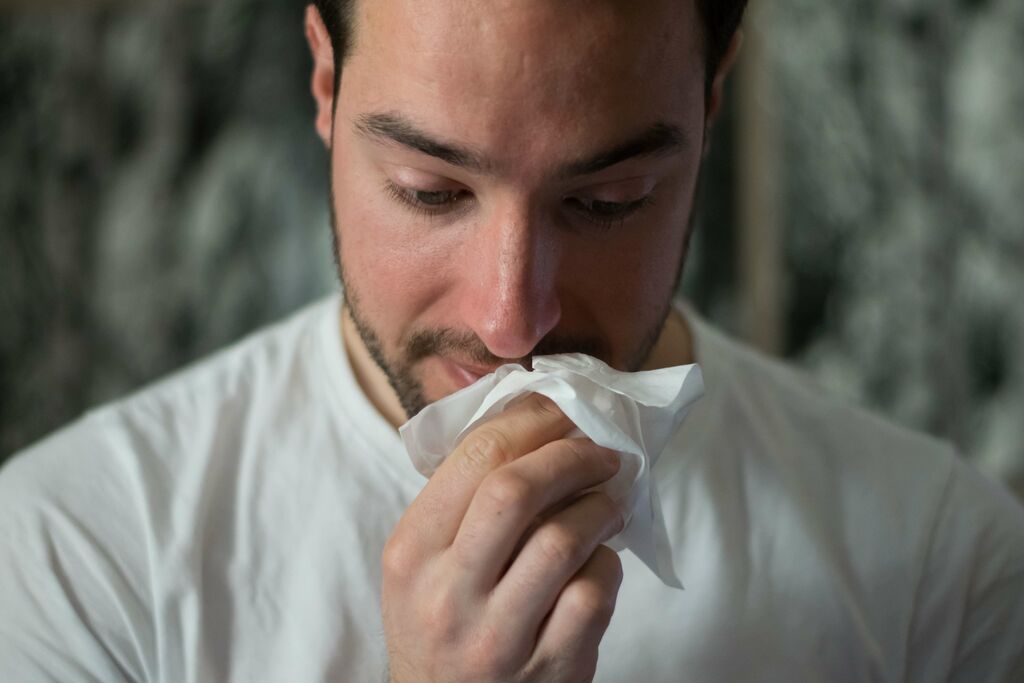Running And Allergies: Everything Needed To Know

Springtime is one of the nicest times of the year. Runners can’t wait to get outside, breathe in the fresh air, shed some layers, and enjoy some time in nature. But spring also keeps many people inside: those with allergies. It can be hard to breathe, see through watery eyes, and stop sneezing. This makes running with allergies in the spring seem impossible.
Sure, it might be best to keep runs indoors when the pollen count is bad. But there are ways to make it through the spring with allergies. Here’s everything you need to know about running with severe spring allergies—and how to survive spring runs.

Is It Even Safe—Or Smart—To Run With Allergies?
Yes, and no. Those with asthma should not run with allergy symptoms are flaring up. Allergies an only bring on exercise-induced asthma. Keep in mind that running with asthma is possible and actually is healthy if the asthma is under control. However, if there is any symptoms take a rest day instead.
Runners know it is safe to run if they feel unwell if the symptoms are above the neck. This includes a runny nose or a headache. Anything below the neck like chest congestion, fever, body aches or upset stomach calls for rest. The same applies for allergies.
Depending on the year, allergies can be really bad. It can bring on hay fever and body aches. Even if training for a race, take this day off to get better. Even though a runny or stuffy nose or itchy throat is fine to run with, symptoms can be intense on particular days. Use these for cross training or to hit the gym treadmills if need be. Avoiding outdoors might be what is best—and smartest—when allergies are bad.
How To Manage Outdoor Runs With Allergies
Make sure to take allergy medication or over-the-counter medicines like nasal sprays and decongestants. Check the weather to see when allergen counts are high to avoid running outdoors. This might mean making adjustments to the time of the day for the outdoor run.
According to the American Academy of Allergy, Asthma, and Immunology, pollen counts are typically the highest from 5 a.m. to 10 a.m. Air quality is also bad in the afternoon. This means pushing a run in the park to the early evening after work instead of at sunrise.
Protect the face as much as possible when running outdoors. This means sunglasses to keep pollen from watering the eyes, and a buff or bandana to be worn to cover the mouth and nose as much as possible.
While some opt for allergy meds, others might not have success with these. Others may prefer not to take medication, even to treat allergies. Some might not have symptoms severe enough to warrant allergy medication. Surviving spring allergies might be possible by treating symptoms more holistically. This includes using honey, a remedy to treat sore throats and colds. Having some tea with honey or honey on some toast with or without peanut butter can also serve as a pre-run snack.
Besides its health benefits, some believe that since bees help pollinate, that pollen is transferred to the honey. This means it becomes a natural vaccine in a sense.
Many runners embrace essential oils. Lavender, peppermint, eucalyptus, chamomile, and lemon are all options that are linked to having benefits. These are best used in a diffuser, especially in the morning when symptoms are the worst.
Other proactive things to do is to eat foods that have anti-inflammatory properties that can greatly help like apples, spinach, turmeric, and avocado.
It’s important to take running clothes off immediately and throw them in the wash. Take a shower to get rid of the allergens once home.

Surviving Spring Allergies As A Runner
One of the best tips for running outdoors in the spring is to do so after it rains. This washes away all the pollen so symptoms should be less severe.
Take the time warm up once arriving at the place of the run. Use a proper amount of time to get the blood pumping. Let the lungs open up during the dynamic warm up. Start slowly for the first half mile to a mile to really get the body ready for the run. Then take off when feeling good.
Make sure to also pay attention to breathing when running. It’s best to breathe in through the nose and out through the mouth. This is the proper way because the nose filters the air.
When it’s just too green out there, don’t fear the treadmill. Using the treadmill every once in a while is actually beneficial since it switches up the normal routine. The runner can run intervals for speed or set an incline for hill work.
While we want to run as much as we can outside after the winter, spring allergies are an unwelcome hurdle. The good news it too will pass and these elements just make us stronger runners.
Latest Articles
 Is Running on a Treadmill Easier Than Running Outside?Runners have their own preferences, whether it is treadmill running, running outside on the road, or exploring trails. So...
Is Running on a Treadmill Easier Than Running Outside?Runners have their own preferences, whether it is treadmill running, running outside on the road, or exploring trails. So... Is It OK to Use Trail Running Shoes on the Road?While trail running shoes can be used on roads, especially in situations where a runner encounters mixed terrains or pref...
Is It OK to Use Trail Running Shoes on the Road?While trail running shoes can be used on roads, especially in situations where a runner encounters mixed terrains or pref... How to Fix Sore Quads After Running?Rest, ice, gentle stretching, and over-the-counter pain relievers can help soothe sore quads after running. Also, ensure ...
How to Fix Sore Quads After Running?Rest, ice, gentle stretching, and over-the-counter pain relievers can help soothe sore quads after running. Also, ensure ... 10 Fruits With The Most Electrolytes to Replace Sports DrinksThese fruits are high in electrolytes such as potassium, magnesium, and calcium, essential for hydration, muscle function...
10 Fruits With The Most Electrolytes to Replace Sports DrinksThese fruits are high in electrolytes such as potassium, magnesium, and calcium, essential for hydration, muscle function...

